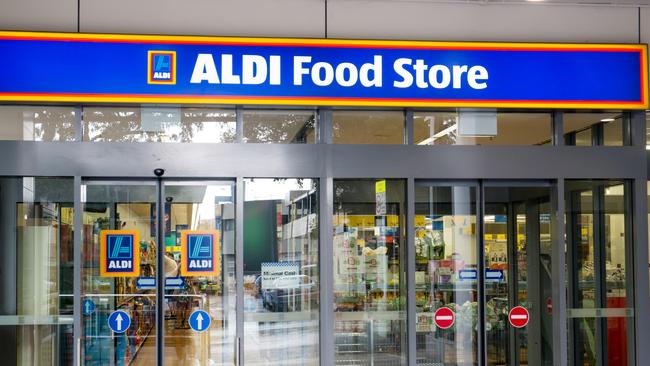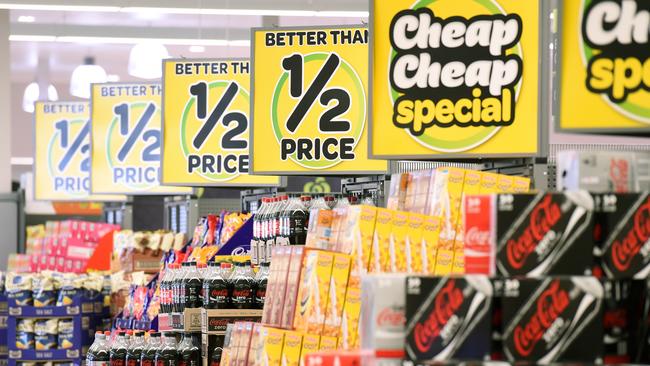Aldi becoming a ‘viral movement’, on track to reach $15 billion in sales by 2020
EVEN if you don’t buy your groceries at Aldi, you’re still winning. And with Aldi set to grow, it’s only going to get better.
SHOPPERS can expect grocery prices to keep coming down as Coles and Woolworths battle it out to prevent more Australians defecting to Aldi, one retail expert has predicted.
Ron Wood, director of retail consultancy PricingInsight, said shoppers could expect to see continued price pressure on “selected categories” as Coles and Woolworths battle to hold share.
“Customers are going to be trialling and adopting Aldi products more regularly,” he said.
“There’s a viral movement where people are trying and being surprised by the quality. The marketing of price that Coles has so successfully executed will diminish as an effective lever to drive sales.”
Mr Wood, a former commercial director with Goodman Fielder, described claims by the big two to be constantly driving down grocery prices as “smoke and mirrors”, with basket staples kept artificially low while high-value items increase.
“For the last 10 years I’ve been tracking 1kg plain flour at Woolworths. It has not changed its price from 85c. The reason it stays at 85c is because it’s one of the basket items measured by companies like Choice,” he said.
“But when it comes to high-value items like specialty cheeses, dairy, chilled yoghurts, where you’ve seen a premiumisation of those categories, prices have all gone up. Overall grocery prices have actually increased over the last three years.”
Mr Wood said Aldi had managed to strike deals with local suppliers for products like potato chips, dairy, cheese, pastry and tinned tomatoes at anywhere up to 30 per cent lower than the supermarkets.
“Suppliers are happy to do this because any dollar they make from Aldi is adding profit, and if they don’t do it someone else will,” he said. “Aldi’s been able to bring a completely different economics to the table.”
But as Aldi puts greater pressure on Woolworths and Coles, they in turn will put greater pressure back on the suppliers to reduce their prices. By “feeding the Aldi machine”, they have unwittingly hurt themselves, Mr Wood argues.
“The tailwind behind Aldi is the that salaries and wages have not increased anywhere near the cost of living,” he said. “Aldi represents a real solution for people who have budgetary issues.”
The German discount chain is on track to increase its share of the Australian food and liquor market from 6 per cent to 10 per cent by the end of the decade, according to new analysis.
Investment bank Morgan Stanley has tipped Aldi chain to reach $15 billion in sales in 2020 as more Aussies make the switch from the big two.
According to Morgan Stanley’s analysis, Aldi customers spend just more than $100 in a four-week period, compared with $220 at Coles and $258 at Woolworths.


Aldi’s basket size has increased by nearly 70 per cent since 2007, when customers spent $60. In the same period, Coles increased its basket size 22 per cent and Woolworths 18 per cent.
“But we do think that it can close the gap to Coles and Woolworths,” Morgan Stanley analysts Tom Kierath and Monique Rooney wrote in an investor note yesterday.
“Clearly, the headwind for the Australian supermarkets has only just begun.”
Analysis of supermarket visitation and basket size trends “[indicate] reasons for Aldi’s success, Coles turnaround and Woolworths demise”, they write.
“Aldi’s 2020 sales (and beyond) estimate is perhaps one of the most important when assessing any investment in listed supermarkets in Australia.”
While 10.5 million customers shop at Woolworths in a given four-week period compared with 10 million at Coles, Coles receives more customers on a per-store basis (12,861 versus 10,900) despite Woolworths stores being 6 per cent larger.
Since 2007, Coles has increased visitation per store by 21 per cent while Woolworths has declined 5 per cent. Aldi’s visitation per store declined by 2.6 per cent in the same period due to its rapid expansion.
According to Morgan Stanley, this would explain why Coles has 8.5 per cent higher sales per square metre than Woolworths.
“Assuming Aldi reaches the East Coast’s current penetration in South Australia and WA and basket size growth of 6 per cent per annum [compared with 6.7 per cent growth between 2007 and 2015] Aldi reaches $15 billion in sales by 2020,” they write.
Aldi’s last reported sales in Australia were $5 billion in 2013. Morgan Stanley predicts 2015/16 financial year sales of $8 billion.
Aldi has an opportunity to grow its basket size by increasing the number of items each customer purchases per shop.
“Aldi customers tend to start out buying staples — products that have a very low risk of failure — i.e., sugar, toilet paper, rice and dishwashing liquid,” Kierath and Rooney write.
“After these products have met consumers expectations, they buy more products, moving into other dry grocery lines. Again, after these expectations have been met, the last category customers graduate to is fresh food.”
On Friday, consumer research company Roy Morgan said Aldi was continuing to increase its market share, increasing from 11.6 per cent in March 2015 to 12.1 per cent in December.
Woolworths still holds the top spot with 37.3 per cent market share, but this has declined from 38.5 per cent.
Number two Coles continues to narrow the gap, increasing its share from 31.8 per cent to 32.5 per cent. IGA has held steady on 9.7 per cent.
In an average four-week period, 5.3 million Australian consumers shop at Aldi, 10.5 million shop at Woolworths, 10 million shop at Coles and just over four million shop at IGA, while almost four million frequent other supermarkets.
But while Aldi’s dollar share of the market is just under one-third of Woolworths, customer volume is a different story. Aldi holds 36.8 per cent share of total grocery buyers, or around half of Woolworths 72.5 per cent.




